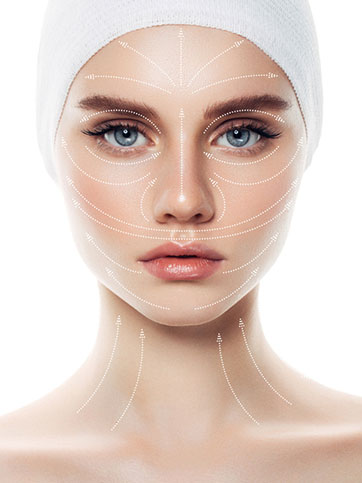
Excellent article and our comments are in blue text below
Allure Magazine’s 11 Most Overrated Cosmetic Surgery Procedures
New cosmetic procedures often fail to live up to their original promise. Some may even do harm. We investigate the innovations that you might want to reconsider.
By Joan Kron

THE “VAMPIRE” FACE-LIFT
This ghoulish-sounding treatment for the signs of aging was introduced in 2009 and has since been mentioned on 200,000 Web pages. It involves injecting the patient’s own pale yellow blood plasma around the eyes and mouth, borrowing a technique used to promote healing after orthopedic surgery. It’s not actually a face-lift, and it’s not FDA approved for use in the face. There are no independent studies proving its cosmetic benefits, though some doctors believe the growth factors in plasma can gradually stimulate collagen production. For results that will be noticed immediately, doctors often add Juvéderm, a hyaluronic acid filler, to the plasma, creating confusion about which substance is doing the plumping. Since plasma extraction can add more than $1,000 to a filler bill, many dermatologists now recommend that patients stick with a wrinkle-fighting method that’s proven to work, such as a filler used on its own.
Not sure we agree on this one. PRF studies have been proven to produce both new Collagen & Elastin production. It is however not an “instant gratification” treatment taking months to see the benefit and many of our patients love this procedure and do see results.

LASER LIPOSUCTION
Using a laser to enhance traditional liposuction may sound like a scientific advance, but many doctors have their doubts. Six years ago, surgeons began promoting the device as an efficient way to melt fat with high heat before removing it from the body. In reality, so-called SmartLipo and similar procedures add both time and money to the typical technique. First, a laser wand is inserted under the skin, then another tube vacuums out the fat. The benefit of the heat is better skin tightening, with more elasticity and less bruising, says Barry DiBernardo, a plastic surgeon in Montclair, New Jersey. The downside? “There is the added risk of burns, large scars, tissue hardening, and prolonged pain,” said Steven Teitelbaum, a plastic surgeon in Santa Monica, in a debate with DiBernardo at last year’s meeting of the American Society for Aesthetic Plastic Surgery. (Cynosure, the company that makes SmartLipo, acknowledges “a very small” number of “uncomplicated” burns from the procedure. In one study, laser-assisted liposuction was seen to have fewer complications than the traditional method, according to the company.)
I’ve been saying this for years. Great marketing term (Smart Lipo so everything else must be dumb, right…) with very little to back up the claim. Dr. LaGrasso found similar issues which is why he chose the VASER (Ultrasound energy) instead of a Laser for advanced body sculpting, high definition body sculpting, fat transfer and cellulite reduction.

THE STEM-CELL FACE-LIFT
They may be the great hope of modern medicine, but stem cells—those blank slates of the body that can turn into nerves, bones, or cartilage—have yet to revolutionize aesthetic surgery. It’s been a decade since scientists discovered that fat happens to be loaded with the cells. Almost immediately, surgeons began to claim—with no proof—that the stem cells in fat improved skin quality and started calling fat injections a stem-cell face-lift, says Rod J. Rohrich, chair of plastic surgery at the University of Texas, Southwestern, in Dallas, and the coauthor of a recent paper on the subject. But the idea that fat injections could replace a traditional face-lift is “high on marketing and short on science,” Rohrich says. “Stem cells have great promise, but there is so much conjecture.” Currently, there is no FDA-approved device to separate stem cells from fat and no consensus on the number of cells needed for rejuvenation or how many treatments are necessary. “We don’t even know if stem cells are critical—or if they are doing anything at all,” says Rohrich.
We agree this is still an evolving area that needs far more study. Stem cells may one day be the future of skin rejuvenation but more testing needs to be done.

SCULPTRA AND ARTEFILL FOR LIPS
Approved in 2004 for patients with facial wasting (a hollow-cheeked appearance usually associated with HIV infection), Sculptra is a chemical that can be injected into the face to stimulate collagen growth. “You put it in and watch it grow over a period of months,” says Claudio DeLorenzi, a plastic surgeon in Kitchener, Canada, who says the best results are seen in the temples and cheeks. But one place it should never be used, says DeLorenzi, is in the lips: “It can result in ugly bumps and lumps, or the lips may end up a size that no one counted on.” Similarly,Artefill, a mixture of Plexiglas-like beads and cow collagen, is approved only for filling smile lines. As the collagen is absorbed, the body forms scar tissue around the beads, DeLorenzi explains. “In the lips, this can result in clumps and nodules, and there is no way to get rid of the stuff other than to cut it out.” Cosmetic surgeons often disagree, but on this subject they are virtually unanimous: Only temporary fillers such as Juvéderm and Restylane should be used in the lips.
Fully agree and just say “NO” if anyone tries to inject your lips or under eyes with Sculptra or Artefill and let’s add in Radiesse as well. All three are in truth great products for other areas of the face but not for the lips or under eyes.

SILICONE CHEEK IMPLANTS
The news for women who want to add volume to their cheeks is good: Facial fillers have all but replaced the silicone implants that were standard in the ’90s. Back then, implants were anchored below the skin, adding plumpness that in some cases, like that of surgical early adopter Jocelyn Wildenstein, verged on the extreme. “Implants can migrate and cause infection and nerve injuries, and the aesthetic result is difficult to reverse,” says Stafford Broumand, an associate clinical professor of plastic surgery at Mount Sinai Medical Center in New York City.
With what we can accomplish in the cheek area with fillers there is no need to undergo a procedure like this. Fully agree…

ULTHERA
Women in their 40s and 50s had high hopes for Ulthera, a no-incision ultrasound treatment approved for eyebrow lifts that was soon put to use in other areas of the face and neck. There’s only one problem: Even when the face is slathered with numbing cream, the procedure can be painful. Really painful. “We gave eight patients full-face Ulthera treatments. They all liked the results, and they all said they would never do it again because of the pain,” said Arie Benchetrit, a Montreal plastic surgeon, at a recent plastic-surgery meeting. “One patient asked to stop midtreatment.” An improved, lower-frequency version designed to reduce the pain without compromising the results was rolled out in October.
Another device we tested that’s simply not ready for prime time… We achieve “much” better skin tightening with our Exilis Elite and do so with no pain. I thought the Ulthera was the most painful device I’ve ever personally tested. A giant “OUCH”…

FAT INJECTIONS FOR BREASTS
There’s a good reason “fat injection” is the latest catchphrase in cosmetic breast augmentation. The results look good and feel natural, and unlike a scalpel, the needles leave no scars. But there are often downsides. Multiple procedures may be necessary and, with few exceptions, provide, at most, a one-cup-size enlargement. A study by Mihye Choi, an assistant professor of plastic surgery at NYU School of Medicine, found that half the volume created by shots of fat disappears into the body within months. More worrisome, there is concern that, years later, stem cells in the fat might stimulate cancer.
I’ve spoken with Dr. LaGrasso about this quite a few times as it sounds like a great procedure. He listed all the above as a downside plus added that when some of the fat dies or calcifies, it may also produce false positives on a mammogram.

BRACHIOPLASTY
Anyone seeking an upper-arm lift to look sleeker in a sleeveless dress may want to keep a cardigan on hand. Only those with very little extra skin and good elasticity qualify for the type of brachioplasty operation in which fat is extracted through an incision that can be hidden in the armpit. For the rest, surgery to reduce arm wattle will result in a scar that runs from armpit to elbow. Nerve problems are also a possibility, and the incision can pull apart and become infected. Brachioplasty may be a great option for the Biggest Loser crowd—women whose arms look like bat wings after massive weight loss—but not for those who just want to dress like Michelle Obama.
Agree for the most part except for patients that have experienced massive weight loss as it’s the only option. For the vast majority of patients the Exilis Elite while it won’t eliminate the laxity can definitely help with improving the tone, texture & laxity of almost any area of the face or body.

BUTT IMPLANTS
Brazilians are famously adventurous when it comes to surgery—they invented the “full-body lift,” after all—but the nation’s thong-wearing beachgoers have turned their backs on butt implants. “Even in the hands of expert surgeons, the reoperation rate for gluteal augmentation with implants is 13 to 25 percent,” says John Sherman, a surgeon at Weill Cornell University Medical College in New York City who surveyed studies on the subject. “You’re putting an implant in a place where there is no anatomical pocket and then constantly sitting on it,” says Sherman, who does not perform the surgery. Risks include infection, wound opening, loss of feeling, and extrusion. As a result, fat injections in this part of the body have become more common.
Fully agree and with Dr. LaGrasso being one of the best Brazilian Butt Lift Surgeons in the country, implants are simply not necessary. Dr. LaGrasso uses VASER to remove fat from areas of excess and transplants the health fat in the buttocks which provides that lift so many patient want.

ZERONA FAT-MELTING LASER
This high-tech slimming technique promises to help patients lose inches without the drudgery of dieting, with maybe just a little unpleasant tingling. The patient lies on a table—20 minutes on the back, 20 on the stomach—while a red laser flashes from the machine’s arms to target and drain fat deposits below the skin. When combined with diet, exercise, and supplements that flush fluid from the body, some people do lose body fat—a half-inch here, a half-inch there—but not the rolls of fat that many want to get rid of. Nobody can say for sure how much is caused by the lasers and how much is the result of diet and exercise (although the laser on its own caused fat loss in a Zerona-sponsored clinical trial). For patients who report no benefit at all from a full course of six sessions costing $1,700,Zerona is, in the words of one critic, “a wallet-ectomy.”
We did have the Zerona for a period of time and it worked really well on some patients and not so well on others. Nothing in medicine ever works 100% the same on everyone. We look for FDA approved devices that are proven to work on at least 70% of patients via FDA and double blind medical studies. A device that’s proven safe and statistically demonstrates a 51% efficacy “can” gain FDA approval which is why we spend so much time evaluating technology.

FOOT LIFTS
Except in summer sandals, the foot is rarely on public display—but that doesn’t mean vanity stops above the ankle. Foot surgery is available to make pointy shoes fit better and to shorten second toes that extend beyond big ones; there’s lipo for the little toe in cases where it’s not little enough, and injections of hyaluronic acid to add padding to the balls of the feet (dubbed the “Loub job,” after Christian Louboutin). The complications, however, can be brutal. It took one New York City socialite more than three years to recover from shots in her soles that caused nerve injury and forced her to wear sneakers. “When patients ask to alter the architecture of a foot that has no real disabilities, I advise against it,” says Rock Positano, a New York City podiatrist and director of the non-operative foot and ankle service at the Hospital for Special Surgery.
In a word, “why”… I mean come on, Toe lipo… Although… I have spoken with centers that use Sculptra in the balls of a patients feet with great success.
we’d love to meet you
Schedule a consultation
Are you ready to take the first step towards achieving your goals? Book Now or Contact Us first with any questions today!
Have a Question?




